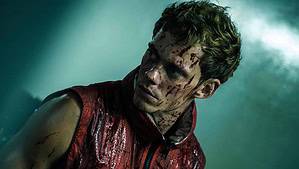Disney has released season 2 of its experimental film series, Short Circuit exclusively on Disney+. It is now playing on the streaming service as of August 4, 2021. If you’re not familiar with the innovative program, it’s where anyone at the Studio can pitch an idea and get selected to create their own short film. Sounds pretty cool, right? Well, we had the pleasure of being invited to a virtual press conference with the directors of the five short films. Moderated by Erin Glover, the panel included Riannon Delanoy who is the director of Songs to Sing in the Dark, Jacob Frey is the director of Going Home, Ryan Green is the director of Crosswalk, Kim Hazel is the director of Dinosaur Barbarian, Liza Rhea is the director of No. 2 to Kettering, and also the glue of the operation, production manager Jennifer Newfield. But before we get into the conversation, let me give you a brief rundown of each short film.

Songs to Sing in the Dark
Two creatures living in the depths of a dark cave engage in a battle of acoustic one-upmanship. As things escalate, they come to realize that they are stronger together.

Going Home
A story about growing up and the meaning of home in which a young adult repeatedly visits his hometown, but with every new arrival he starts to face the inevitable: change.

Crosswalk
A law-abiding citizen must find his inner strength to cross the street at a light that won’t change.

Dinosaur Barbarian
Battling evil is all in a day’s work for Dinosaur Barbarian, but what about taking out the trash? Sometimes even a superhero needs to clean up his act.

No. 2 to Kettering
On a dreary, ordinary morning, a girl learns how the power of laughter can lift even the most sullen among her fellow bus riders along their journey to Kettering.
Now, let’s get to it.
Questions & Responses
To start it off, the directors are asked about the inspiration and relationship they have with their films.
The first to respond is Riannon Delanoy. When asked where she got the idea for Songs to Sing in the Dark, she says:
Riannon Delanoy: My parents are both research scientists and before Short Circuit, even before I was an animator, I spent a lot of time reading and going down information rabbit holes[…] As pertains to this short, some animals like bats, they’re very advanced with their use of sound. They use echolocation navigate, but a few animals use sound for even more than that.
She continues:
RD: Tiger moths can use interference patterns to jam echolocation. Sperm whales can blast sound like a shotgun to stun prey. Dolphins even appear to have a pictographic language where they can send images to one another, and it’s all encoded in sound. What if you took those abilities to their logical extreme? What would happen if you took a group of echolocating animals, and let them evolve for millions of years in this totally dark cave, in this massive evolutionary feedback loop? Maybe sound could become weapons, and armor, and camouflage, and these big threat displays. Maybe you could reinvent your appearance altogether in that kind of environment and project any image you wanted into the mind of your observer. That blue sky possibility for visuals and sound really appealed to me.
Next, Jacob Grey is asked about the difficulty of shifting seasons in Going Home.
Jacob Grey: It definitely added another layer of complexity to the shot, especially from an asset level where we needed different variations of foliage trees for autumn, winter, and spring, but it also added complexity for editing because we need to lock down those cuts fairly early before we started animating. […] Also then creating this whole library of assets to populate a whole city, and for different seasons. It was definitely more work than just having one season.
Following Jacob is Ryan Green explaining the familiar experience that takes place in Crosswalk that all his colleagues can attest to.
Ryan Green: Yes, there’s a light right outside of Disney Animation building, and I think all of us have waited there many times. You can see way down the street in both directions, there’s very little traffic and the light takes forever. I just remember standing there one day just waiting, and waiting, and waiting. I just pictured my ancestors showing up next to me just be like, “Hey, what are you doing? We wanted to make a better life for ourselves, so we got on a boat and crossed the Atlantic. We didn’t wait for a robot to tell us to do it. Why are you just standing here? You can see, you can cross the street.” That just basically became the seed of the idea.
The director of Dinosaur Barbarian, Kim Hazel is asked about the pitching process and the courage it takes to do it.
Kim Hazel: It was actually Riannon who encouraged me to submit my idea to the program. I probably wouldn’t have done it without her encouragement. She was really Dinosaur Barbarian‘s number one fan from day one.
Liza Rhea is then as if there is actually a number 2 bus that travels to Kettering.
Liza Rhea: It’s really funny that you should ask that because when I told my mom the title of my film, her response was, “But the number two doesn’t go to Kettering.” […] We met with her friend, and we were like, “We have to settle a bet here, does a number two still go to Kettering?” They were like, “No, no, no, but it used to.” In the ’90s, when I got the bus, there was a number two to Kettering, but I guess there technically isn’t anymore.
Production manager Jennifer Newfield is then asked what makes season 2 of Short Circuit unique and exciting.
Jennifer Newfield: […] What’s just thrilling about Short Circuit as a program overall is that we’re always looking for new and innovative ideas. All these brand new directors get to bring something different to the table.
She adds,
JN: […] the directors get to influence each other. They get to pay it forward almost from their shorts to the next season, and get to bolster each other up and help each other have different creative visions come to the screen. I think they’re all really excited about exploring new mediums, or at least new ways of working with the tools that we have in our studio. That encouragement just ends up with something unique on-screen every time a short rolls through.
When being asked about the difficulties of telling a fully fleshed-out 90-second story, they had this to say.
Jacob Grey: It is very tough to tell a full story in a short amount of time and really making sure that all the beat that are trying to tell are a part in those two minutes […] That’s why I spent a lot of time with the storyboarding, but also layout, to really make sure that everything works the way we want it, and it has everything in there.
He adds:
Animation in general is just really complex and takes a lot of work. Whether that’s 2 minutes or 90 minutes, it requires a lot of people and it doesn’t really get easier if it’s shorter.
Riannon Delanoy: I had the advantage of having a soundtrack before we started. All I did was just basically confine it to 90 seconds. Fortunately, one of the big things I looked at was just really simplifying the plot, because the more stuff you try to cram in, the more it tends to balloon out once you get into editorial and animation. […] Also having a soundtrack really helps, because then it’s like you’re locked to that timing.
Liza Rhea: I have to second both Jacob and Riannon there about the story beats, and condensing them, and strengthening them. […] There was a lot of figuring out, maybe we can manipulate the shape and sizes, or facial features, and skin tone, and clothing, using lurk, and animation, and blend shapes. […] I hope they look different from other films. That was the biggest challenge for me was trying to make the characters look unique as possible.
Ryan Green: […] I had to think what’s important to just this piece since it’s so short and so I went with comedy, and made it more lighthearted. Even character-wise, just decided, there wasn’t enough time for a full intro on a character, and so I just tried to make them more of an everyman that you could easily just get at a glance, and understand […]
Kim Hazel: I actually picked Dinosaur Barbarian as a song intentionally to tell the story I wanted to tell within the time allotted for Short Circuit. […] From the beginning, it was designed to be like a snack. At that point it was– I don’t know, I’m just happy it all worked out.
Lastly, Jennifer is asked how she manages to keep everyone on track and in their elotted time.
Jennifer Newfield: I’d say that partnerships are so important. All along the way, the partnership between creative and logistics and every part of the animation is essential and crucial and something obvious. […] For me, I think my partnership with the directors makes that function in a really unique way, because I’m always keeping their top priorities of creative in mind.
She continues:
JN: Ideally, we have a little bit of a runway until they start after they get selected, so we can have really deep conversations and I can draw out from them what their goals are, factors both creatively, but also what they want to get out of the program, what they want their focus to be. […] Ultimately, we come to a similar agreement, especially because there’s such a swath of amazing projects that go on in this program at any given time, and everyone is all about equality to every project as well. Knowing that they want to spread the love to future Short Circuits and we try to keep that in perspective as we go along.
Season 2 of Short Circuit is now streaming exclusively on Disney+. Stay safe and enjoy.








